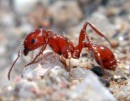Plants may compensate for early seed loss, when nutrients are not limiting, by increasing the size of the remaining fruit and seeds. In addition, additional flowers and fruits may be produced. Longer-term genetic changes in plant populations in response to the (natural) selection by predators for seeds may result in:
- delay in seed release
- change in the number of seeds matured and released
- increase in the heterogeneity of seed size, seed release, and seed distribution in the soil
- selection among differentially susceptible genotypes
- compensatory production of seeds that differ in certain key traits
 In North American deserts, granivorous species, such as heteromyid rodents (e.g., pocket mouse) and harvester ants, may:
In North American deserts, granivorous species, such as heteromyid rodents (e.g., pocket mouse) and harvester ants, may:
- reduce seed densities in the seed bank by 30-80%
- reduce overall plant density
- select among seeds and deplete seed pools of the larger seeded shrubs and herbs
- contribute to the spatial heterogeneity of seed distribution
- differentially decrease seed and plant abundance of some ruderals but not of most of the characteristic ephemerals.
 Both predispersal and postdispersal seed predation were measured in Cirsium canescens, a native plant that colonizes disturbances. This short-lived perennial thistle is dependent on seed regeneration for population maintenance, as are other fugitive species. Predispersal predators were excluded with insecticide and postdispersal predators were excluded with small-mesh cages.
Both predispersal and postdispersal seed predation were measured in Cirsium canescens, a native plant that colonizes disturbances. This short-lived perennial thistle is dependent on seed regeneration for population maintenance, as are other fugitive species. Predispersal predators were excluded with insecticide and postdispersal predators were excluded with small-mesh cages.Predispersal seed predators decreased seed input into the seed bank and reduced potential contribution to the next generation of thistles. Postdispersal seed predators decreased seedling recruitment. Comparison with controls showed that seed predation significantly reduced plant density and reproduction.
| Parameter per plant | Insecticide exclusion (mean ± SE) | Water control (mean ± SE) |
|---|---|---|
| Seeds Initiated | 716 ± 77.9 | 577 ± 60.9 |
| Viable seeds released | 105 ± 11.2 | 41 ± 5.6*** |
| Seedlings | 3.0 ± 0.48 | 0.5 ± 0.19*** |
| Monocarpic adults established | 0.37 ± 0.11 | 0.07 ± 0.03** |
| **: p < 0.01; ***: p < 0.001 | ||